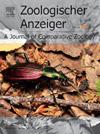首次证明泥龙(kinorhyncha)的隐性多样性,并描述来自东北太平洋海岸的 Echinoderes quasae sp.
IF 1.2
3区 生物学
Q2 ZOOLOGY
引用次数: 0
摘要
棘皮动物属目前有 150 多个已知物种,自 2015 年以来,该属的新描述激增。物种鉴定传统上依赖于形态特征和形态计量学,但由于特征重叠和特征变异,区分近缘物种越来越具有挑战性。隐性多样性是指物种在基因上不同但形态上相同,这在小型底栖动物中很常见,在近缘种中也被怀疑存在隐性多样性,但之前并未得到证实。本研究利用新收集的材料和史密森尼国家自然历史博物馆的历史藏品,对东北太平洋棘皮动物群进行了研究。我们使用分子和形态学方法描述了一个新物种 Echinoderes quasae sp.本文章由计算机程序翻译,如有差异,请以英文原文为准。
First evidence of cryptic diversity in mud dragons (kinorhyncha) and description of Echinoderes quasae sp. nov. from the northeastern pacific coast
The genus Echinoderes, currently consisting of over 150 known species, has seen a surge in new descriptions since 2015. Species identification traditionally relies on morphological traits and morphometrics, but distinguishing closely related species is more and more challenging due to overlapping features and character variability. Cryptic diversity, where species are genetically distinct but morphologically identical, is common in meiofauna and suspected in kinorhynchs, though not previously confirmed. This study examines the northeastern Pacific Echinoderes fauna, using newly collected material and historical collections of the Smithsonian National Museum of Natural History. We describe a new species, Echinoderes quasae sp. nov., using a molecular and morphological approach and provide the first evidence of cryptic diversity in kinorhynchs, revealing at least two new species within a previously unrecognized cryptic complex.
求助全文
通过发布文献求助,成功后即可免费获取论文全文。
去求助
来源期刊

Zoologischer Anzeiger
生物-动物学
CiteScore
2.80
自引率
7.10%
发文量
75
审稿时长
>12 weeks
期刊介绍:
Zoologischer Anzeiger - A Journal of Comparative Zoology is devoted to comparative zoology with a special emphasis on morphology, systematics, biogeography, and evolutionary biology targeting all metazoans, both modern and extinct. We also consider taxonomic submissions addressing a broader systematic and/or evolutionary context. The overall aim of the journal is to contribute to our understanding of the organismic world from an evolutionary perspective.
The journal Zoologischer Anzeiger invites suggestions for special issues. Interested parties may contact one of the editors.
 求助内容:
求助内容: 应助结果提醒方式:
应助结果提醒方式:


